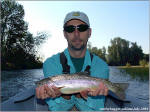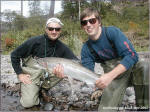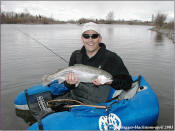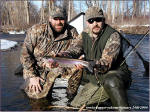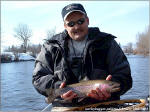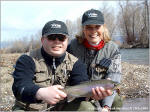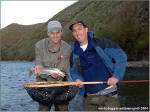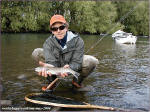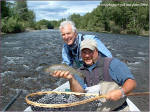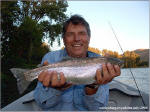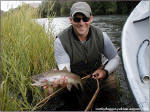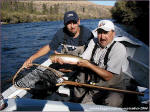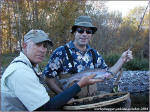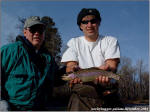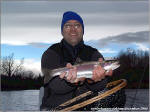|
December
22nd-2004 |
|
|
|
|
As Christmas Day
approaches, the mild Fall like temperatures continue to
reign throughout the Yakima River Basin. Unseasonable
winter days filled with afternoon sunshine and near fifty degree
temperatures have been common. |
|
|
|
WBFC Winter Guided Tour Info. |
|
During the winter months of December, January and
February Worley Bugger Fly Co. will be conducting
guided tours on Central Washington's, Yakima
River. Enjoy a day of fishing in peaceful
solitude, floating in warm, comfortable drift
boats. Learn the techniques required to catch
Yakima rainbows during the mild winter months of
the season. Day and Half Day tours are available
as well as our very popular 4+ hour Winter tour.
|
|
|
|
|
All Flies Are Provided On Our Guided Tours. |
|
|
|
|
Fog banks not
uncommon this time of year have occasionally settled in the
Kittitas Valley during the night, however most days the
early afternoon sunshine burns through creating spectacular
December fishing days. |
|
|
The river has
settled out over the past several days after last week's
heavy precipitation.
River flows are
back in the normal operating levels for this time of year.
|
|
|
At this
time, not a skiff of snow resides along the river banks and
the low lying hills that encircle the Ellensburg Valley are
nearly barren. These circumstances make for ideal
winter time fishing. |
|
|
However,
without an abundant snow pack in the Cascades, water
conditions this coming summer could be horrendous.
Lets hope we see several winter storms pass our way
during the months of January and February. |
|
|
|
|
|
From the
staff, management and professional guide service of Worley
Bugger Fly Co., we wish everyone a safe and happy holiday
season. We thank all our friends and patrons that have
supported our efforts over the years and our pro shop and guide
team looks forward to serving your fly fishing needs throughout
the 2005 season. Merry Christmas! |
|
|
|
|
|
After a succession of
warm days, the Yakima River was subjected to the winter elements
as a heavy laden down pour moved across the Kittitas Valley late
last week. Under most circumstances, the Central Basin
would have been blanketed in snow this time of year.
However, mild day time conditions and temperatures continued as
the snow accumulations remained in the higher elevations of the
Cascades. |
|
|
|
The thin layer of snow
that had been covering the low lying hills and stream sides was
discharged into the Yakima's main tributaries, swelling their
small banks. Blasts of cool, cloudy water hurried down
these small inlets eventually colliding with the Yakima,
creating higher streams flows and less favorable fishing
conditions. |
|
|
|
Cooler, drier December
temperatures have once again sent the river volume plummeting.
Sand and sediment have settled and water clarity has returned. |
|
|
|
During periods of
long sustained low river flows, cooler water temperatures
and minimal insect activity, trout sustenance becomes
less available to our resident fish. Common sense
tells us that fish of sufficient size can only sustain
themselves for a period of time on small aquatic insects
like Midges and Midge Larvae. Other dietary
consumptions are required. |
|
|
When weather
incidences occur and a rush of water filters through the
river system, a variety of food sources not present before
hand in the water column becomes vulnerable and available
during these periods. |
|
|
Generally
these food forms are present for several days following.
This creates more feeding opportunities for fish as they
feed indiscriminately on these sources. |
|
|
|
|
"Current
Insect Activity" |
|
|
|
|
|
|
|
|
|
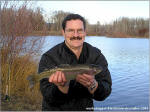 |
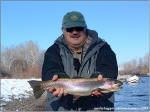 |
|
Blackstone |
Yakima |
|
|
|
|
|
W.B.F.C
Pro-Shop Hours Of Operation |
|
8:00
a.m.-5:30 p.m |
|
7 Days A Week |
|
|
|
|
|
|
|
"Yakima River Flows" |
|
 |
Easton Flow |
450 cfs. |
 |
Cle Elum Flow |
695 cfs. |
 |
Teanaway Flow |
315 cfs. |
 |
Eburg Flow |
1075 cfs. |
 |
Umtanum Flow |
1070 cfs. |
|
|
|
|
Cased Caddis,
several strains of Mayfly nymphs, Sculpins as well as
Stonefly nymphs all become a viable food source for
Yakima fish during these periods. Once the river
settles and returns to normal winter flows, trout
displaced by the higher flows will once again congregate
throughout the winter runs of the river. Aquatic
insects will settle and the diverse feeding
opportunities will diminish. Whitefish active in
their spawning rituals will resume their activity as
well. |
|
|
|
A Worley Bugger Fly
Tying course will be held after the new year. If
interested, please feel free to contact the pro shop in
Ellensburg for more information. |
|
|
|
Are you still looking
for the perfect Christmas gift this year? May we suggest
a
Guided Tour Gift Certificate
from Worley Bugger Fly Co. Presented to a loved one,
employee or friend on Christmas Day makes the perfect present. Guided tour gift certificates can be
purchased securely online or by simply calling the pro-shop
(888-952-FISH).
For questions or assistance,
feel free to contact the Worley Bugger pro shop. Guided
Tour Gift
Certificates are available for the
Yakima River,
Klickitat River &
Blackstone Lake tours.
Gift Certificates are also available for
pro shop merchandise. Happy Holidays from the staff and
management of Worley Bugger Fly Co.! |
|
|
|
|
|
As the start of the
holiday's season begins, a light dusting of snow now covers the
Kittitas Valley hillsides. Many fly anglers stow their gear at
the first signs of cold or changing weather, much to early for
this centrally located desert river. The 2004 fishing
season still has plenty of life in it yet. Mild, blue bird
fishing days through the month of November kept aquatic
insect hatches alive and fish active and attentive to the fly. |
|
|
|
The daily Baetis hatches
have begun to slow throughout the lower portions of the
Yakima appearing for only short, sporadic periods of the day or
not at all. However,
attentions are still concentrated on creatures of the
aquatic nature.
Congregations of Midges are now forming on the Yakima and
the river's rainbows are tenuously working in pods as
protruding dorsal fins slice the surface of the water. |
|
|
|
For those fly
fishermen that enjoy the visualization of a wild rainbow
slurping tiny naturals from the surface, target the warmest
portions of the afternoon for this fish foraging surface
activity. This is
intricate, demanding and delicate work with rod and reel,
requiring patience and a keen eye for detail.
A long, thin strand of mono presented ever so lightly is
perquisite for success. For most, subsurface
methods have proven to be a much more effective.
|
|
|
|
Stonefly nymphs as
usual, continue to be the substantial portion of the Yakima
trout's dietary consumptions. This will remain throughout the
days of December and January. Migrations of Skwalla Stone
nymphs is an on going event during these winter months. This
intense migration of nymphs, leads up to the adult activity during the latter portions of February, when
we begin to see water temperatures increase.
|
|
|
|
|
|
|
|
|
|
Cool, crisp sunrises
are now a standard affair each day in the Yakima River Valley.
That extra layer of fleece or wool that has been stored away
since spring is needed first thing in the morning under a cover
of Gortex. However, by early afternoon the Kittitas Valley
sunshine is warming everything and that early morning added
layer of clothing is quickly removed.
The
determining
colors of Fall cling resiliently to the foliage and trees
along the Yakima. However, it's a losing battle as the
once dense disguise falls each day, covering the rocky
terrain of the river banks. |
|
|
|
Every afternoon, Fall
Baetis
hatches occur,
some lasting hours at a time, while other days a shorter window
of opportunity for the emergence is presented. Each day is different
and every section of river provides a variety of unique
circumstances. Sections of the lower river from
Ellensburg throughout the lower Yakima River Canyon seem to
provide more consistent Baetis hatches on a day to day basis at this
time. |
|
|
|
Working pods of
slurping rainbows with small dries, sometimes as tiny as #22's
is common. For many of the dry fly enthusiasts this is the
time of year and the challenge of match the hatch fishing you
can experience.
The
rainbows have taken up residency in the winter holding
waters of the Yakima, where the majority of aquatic food forms
are now found.
|
|
|
|
Pods
or schools of fish are common this time of year due to
low water volume, cooler water temperatures and a
specific Mayfly hatch commencing. Find one rainbow
and chances are you have found many.
Working nymph rigs first thing in the morning is common
and should be expected. By noon, warming
temperatures kindle and it's apparent events are going
to begin unfolding.
As a majority
of the aquatic insect hatches begin to wind down for the
season, bigger Yakima rainbows turn their attentions to
another thriving food source. Baitfish such as
Sculpins flourish within the waters of the river and are
a consistent resource for fish throughout the year.
They become a much more important form for large fish
when aquatic insects emergences become less probable.
Don't neglect your streamer box this time of year! |
|
|
|
On Thursday,
November 11th a special day commences. Veterans both past
and present are honored on this day for their self sacrifice and
service to our great country. Thanks to all who have
served and to those who continue their service risking the
ultimate to keep the rest of us safe. For servicemen and
women that read this report and email over sea's----be safe!
From the staff
and management of WBFC, thank you and your families for your
dedication and service. |
|
|
|
For those interested, on November 1st, the guide service of
Worley Bugger Fly Co. instituted its
winter guiding rates for
the months of November, December and January. Individuals
that would still like to fish a full day are still being given
that opportunity by starting early in the morning (8:30
a.m.-4:30 p.m.). For fair weather fishermen or those that
would like to target the specific hatch of dries throughout
November can do so with
a winter tour. Check the website rates or call the pro
shop for tour details and guide availability. |
|
|
|
|
|
With the last week of
October upon us, frost filled morning sunrises are now a daily
occurrence throughout the Yakima River Basin. The
first blanket of new snow has fallen high atop the Cascade
Mountain Range. This added addition of color has constructed a
spectacular Fall backdrop towering over the Kittitas Valley. |
|
|
|
As the Cottonwoods
slowly shed there brilliant golden foliage, afternoon
hatches of Baetis and Mahogany Dun Mayflies continue to
bring slurping rainbows to the surface.
Tiny mayfly imitations in
sizes 18 to 20 are standard criteria for your daily fishing. In some areas of the Yakima, a size 22 may be required to match
the hatch of Fall Baetis. Choose a proportionate pattern in the
appropriate size to duplicate the natural. Low
light conditions may also be a factor during times of intense Baetis
hatches.
Another
factor to consider.
Select a imitation
that is visible fished within the foam lines of the river.
|
|
|
|
Concentrate
your efforts in the frothy streaks of foam gathering throughout
the runs. Here, tiny mayflies are pulled from the current
and find themselves trapped within the confines of the foam.
Trout feed at their discretions on these trapped Fall food
forms. Emerging mayflies also fall victim in these foamy
areas as they struggle to break free of a clinging meniscus.
Subsurface patterns fished in the under lying foam can at times
be much more productive way to match the rainbows feeding
patterns. Mahogany Duns can also play a dynamic role
during this warmer period of the day.
|
|
|
|
Constructing
a system of two tandem
mayflies imitations, one representing the larger natural as your
point fly with a trailing blue wing can provide better visibility
for the fly fishermen. It also offers frugal feeding fish
a diversity, as you display an array of the
natural aquatic insects that are present. Giant Sedges are still
apparent throughout the main stem, however their numbers are
beginning to diminish. |
|
|
|
The river is in
excellent condition with access to a majority of the water available
to both wading and or drift fishermen. |
|
|
|
|
|
|
|
As brisk, frost filled
mornings arise, rays of afternoon sunshine, radiate across the
Yakima River Valley. Cloudless blue skies and temperatures
we expected in September have dominated our central basin fly
fishing days. At twilight, brilliant, picturesque sunsets
adorn the western skies. It's the time of year when Mother
Nature is really at her best, constructing a canvas of
incredible colors along the banks of the river. The once
lush summer vegetation that grew thick under the blistering
summer sun is quickly turning, shedding its summer coat. The
tall Cottonwood trees that so graciously provide us with a
barrier against the harsh Kittitas Valley winds, glow golden
along the banks of the Yakima. |
|
|
|
However, a change
in recent weather patterns is developing and seasonable
conditions are predicted to settle in the valley for the
next several days. A welcome site for Fall fly fishing
addicts.
Cooler days are
expected and gladly welcomed as Fall aquatics thrive among
the cloud cover. Larger fish feel
safe under these conditions and will at times abandon their
apprehensions and feed recklessly on the surface during times
of heavy hatches.
Several mayflies
species in assorted sizes and color are predominate through
the Yakima's main stem at this time. Nymphs, adults
and emergers are all equally important food forms to
recognize. |
|
|
|
Fall Baetis, Lt.
Cahill's, and Mahogany Dun mayfly hatches are occurring in
the main stem during the fishing day. Most days
you can expect to see the emergence of mayflies commence mid
afternoon lasting well into the latter portion of the day.
Baetis are
generally the first to appear ranging in size 18 to 22.
Clouds of these olive dun mayflies are gathering in the foam
lines of the Yakima for several hours at a time. A periodic
combination of Light Cahill's and Mahogany Duns will appear
mixed within the emergence of Fall Baetis. A fly
fishermen's abilities to distinguish and correctly identify
the preferred trout forage will be your task for the day. |
|
|
|
Blooms
of Giant Fall Caddis begin appearing in the late afternoon.
Occasional early morning hatches of Giant Orange Sedges can
also occur. If this transpire, the fish are attuned to
these large adult caddisflies and the first portion of your
day can be dedicated to swinging caddis patterns or skating
large dry fly imitations.
|
|
|
|
|
|
|
|
With the first week of
Autumn underway, warm sun filled fishing days have embraced the
Yakima River Valley. The cool, crisp mornings however are a
reminder that Fall is quickly approaching. As the month of
October begins, daily occasions like these have become renowned
on Central Washington's trout river. |
|
|
|
Warm, breezeless days,
low water volumes throughout the main stem, a mishmash,
picturesque setting of vibrant colors, and a variety of insect
hatches are all coinciding together at this time. |
|
|
|
It's also the time
when Fall
anadromous fish
breach the latter at Roza Dam and begin the rites of
procreation. Fall Kings have moved into specified
areas of the Yakima and are ambitiously procuring areas of the
river for spawning purposes. Thou some may believe the
Salmon are harmful for the Yakima and its resident rainbows
nothing could be further from the truth. These
large fish provide nutrients for both fish and aquatic insects,
nurturing the stream bed while providing an additional means of
forage for all the rivers inhabitants.
|
|
|
|
Over the next several
weeks while wading the shallows of the river, pay close
attention to areas where redds are or have been formed.
Avoid damaging these areas where time and energies have been
consumed by these great fish. |
|
|
|
Light Cahill Mayflies,
Giant Orange Sedge Caddis, Fall Baetis and a sporadic occurrence
of Mahogany Duns are the aquatic fare emerging throughout the
fishing day. Cahill's, Baetis and Mahoganies are an
early afternoon affair. The Giant Fall Caddis are a dawn
and dusk event, taking place in key areas of the Yakima where
large numbers of these spectacular Caddisflies exist.
Upper areas of the river are prone to intensive nightly dances,
while lower Canyon stretches provide an adequate presence of
sedges. |
|
|
|
|
|
|
|
As the days of
September quickly fade away, evident changes are occurring
throughout the Yakima River Valley. With blistering summer
heat dominating the entire month of August, an odd occurrence in
weather is now presiding across the Eastern Basin.
Unseasonable Fall
like mornings and cool crisp fishing days are an unordinary
occurrence for this time of year.
Wet, drizzle filled days haven't been uncommon either as one front after another moves
across the Kittitas Mountain sides. These wet conditions
however are
creating an ideal situation. Over cast fishing days are
prompting an intense hatch of Baetis Mayflies as they literally
cover the surface of the river. The trout eagerly anticipate this
daily monumental feeding opportunity. Light Cahill
Mayflies are also beginning to emerge in areas of the Yakima.
If encountered, this pale mayfly can provide some afternoon top water casting
activity. |
|
|
|
With river flows at an
unusual seasonal low, foot fishermen wading the Yakima from bank
to bank will find worry free access through most of the main
stem. Deep ledges and pools still exist, so move around these
areas carefully. Boat fishermen won't experience any problems
either as long as you adhere to the main stem. One area of the upper
Yakima (East Cle Elum Boat
Launch above the Teanaway)
is at this time
barricaded by fallen timbers and jams, so it should be avoided
until the problem is corrected. Several fishermen have been
held up for hours trying to portage around the mess of logs. |
|
|
|
With the cooler
weather settling into the valley, Terrestrials as well as the
Stonefly fishing has begun to slow. During warmer
afternoons you may find fish receptive to larger dry fly
imitation in some area's of the river where dense thick grasses
and adequate bank water exist. Bushy dry
fly patterns fished as a point fly with a extended bead head
dropper has been effective in the right water depths. In deeper
runs and pockets avoid this technique. Indictor
fishing in the deeper runs and pools is much more efficient. Fish the appropriate
and productive method for each set of circumstances you
experience throughout the runs of the river. |
|
|
|
Its the time of year
when Giant Orange Sedge Caddis become a mainstay in the
trout's daily diet. A good hatch of adult sedge's is
now occurring in the portion of the Upper Yakima.
Pupa patterns are especially important and should not be
overlooked, especially during the latter portion of your
fishing day. Free floating Sedge Caddis will at many
times break free of the case and swim throughout the water
column, providing a big, easy target for the Yakima rainbow. |
|
|
|
Click To Enlarge
Thumbnail |
|
 |
|
"Giant Orange Sedge Pupa-Adult" |
|
With the steady drop
in temperatures, the still water fisheries of the central desert
are beginning to provide good fishing opportunities once again.
Damselfly activity is still on going on the warmer September
days. Midge and Callibeatis Mayflies are forming the
most interest during the fishing day, especially periods of wet,
cool weather.
Blackstone Lake is no exception. Terrestrial
fishing is beginning to slow at the private still water fishery, however
fish are feisty and foraging throughout the day. |
|
|
|
|
Since the month of
June, a good portion of my off days have been spent in the
southeastern portion of the state.
The Klickitat River
becomes
a constant distraction for us as Steelhead begin moving into
it's waters. The June opener started out slow this year as fish
counts remained low. We had some successes towards the end of
June as better numbers of fish began to move into the
system. However, between fluctuating water conditions and unusual
summer winds, water flows remained
high creating the white glacier discoloration the "Klick"
is famous for. |
|
|
|
The Klickitat hasn't
been immune to the recent rain storms we have been receiving in
the Kittitas Valley either. However, drier conditions in
that portion of the state and cool,
crisp nights in the Lower Columbia Basin are providing ideal
conditions for Klickitat River Steelhead fishing. For
those interested in experiencing this fabulous river this Fall,
please call ahead. We would love to show you the splendor
of this beautiful Fall Fishery. |
|
|
|
|
|
A host of
circumstances is now evolving on Central Washington's Blue
Ribbon trout stream. The Fall flip flop has been initiated, as
the Yakima's river volume continues to recede. As the
beginning of September commences, cooler nights as well as
comfortable, warm day time highs are having a direct effect on aquatic
life as well as water temperatures. |
|
|
|
As terrestrial life
forms continue to prosper in the tall, summer river grasses of the
Yakima, aquatic insects have once again become a inherit
commodity for the Yakima rainbows. Daily feasts no longer
reside with just grasshoppers, ants, beetles or bees.
Attentions are turning to a food form living within the water column
of the river easily
available to the Yakima Rainbows . Don't count the
Terrestrial activity out yet. Its still much to early to
dismiss their importance.
Warm sunny days and inviting afternoon breezes are still making
this food form a valuable asset among the trout. However,
intense hatches of Fall Baetis are occurring throughout the main
stem, Yakima.
|
|
|
|
Over the past week,
giant Shortwing Stones have been taking to flight across the waters
of the Yakima. Activity as of yet has been erratic from
day to day, however as the river volume continues on the down
turn, one can expect this hustling activity to dramatically
increase. The warmer days will of course produce stonefly
activity, especially stagnate areas of the river showing no
signs of a light, afternoon breeze. Stoneflies readily take to
flight at these times taking advantage of the windless circumstances. |
|
|
|
With the absence of
the grueling August heat, water temperatures among the still
waters of the central basin desert are also rapidly descending.
Blackstone Lake, Central Washington's premier, private still
water is now open for Fall fishing. Dry fly activity at the lake
is outrageous! Seventy degree days are producing immense
damsel fly hatches lasting half the day. Giant Hoppers as
well as other terrestrial creatures are abundant along the banks
of the lake as well. Flying ants living within the
Cottonwood trees are a treat for the rainbows as well as the fly
fishermen. As the days progress and Fall begins to settle
into the valley, Chironomid hatches will once again become
abundant. Bookings on the lake are being taken and days
are filling. Please call early to arrange your day at
Blackstone Lake with Worley Bugger. |
|
|
|
Fall is in the air and
is visible in the vegetation and
leaves along the river. Most of the trees still remain
covered in summer color, however
lighter shades are appearing on the branches almost daily.
Water flows are now low. For those on foot fishermen
constricted to the banks since early July, access is now
unlimited to most of the productive water on the river. |
|
|
|
|
|
The triple digit heat
that occupied the Yakima River Valley has now been replaced by cooler, sometimes wet, drizzle
filled days. A reprieve from the heat arrived over the weekend
and is expected to last into the week. A welcome site this
time of year. The cooling effect has created a blanket
of cloudy cover, prompting overcast fishing days. This cooler
weather pattern has in turn reduced the high water temperature
as we watch it's decline. A welcome site after hovering
above the (70˚) seventy degree mark for the past week. |
|
|
|
The river flows have
continued on a gradually descent each day as well, operating at
an unusual low volume for this time of year. However, through most
area's of the lower main stem, the river remains high for
adequate, safe wade fishing. If the normal procedures
follow, one can expect the ""Flip Flop"" operations of the
reservoirs to commence around the first portion of September. |
|
|
|
Terrestrial life
forms continue to be a mainstay in the trout's diet.
Hoppers in a variety of colors (yellow, olive, red and gray)
have produced fine results over the past week.
A summer
afternoon breeze the past couple of days has provided the
necessary ingredient to produce consistent top water action.
|
|
Click To Enlarge
Thumbnail |
|
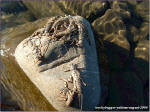 |
|
"Shortwing Stone-August 2004" |
|
One may encounter a
Caddis hatch commencing at dusk, however each section of the
river is not consistently producing a guaranteed emergence
from day to day.
If a bloom of
Caddis does materialize, a bleached wing or a high
riding imitation visible in the low light conditions will
fish well for you.
|
|
|
|
|
Stonefly nymphs in
abundance are providing an added sustenance as we eagerly
anticipate the final stonefly hatch of the season. The male "Shortwing
Stones" have been anxiously congregating along the
banks of the Yakima, impatiently awaiting the arrival of it's
much larger mate. Migration usually commences during the
middle of August and by the first parts of September these
gigantic females are taking flight across the waters of the main
stem Yakima. This year, we expect their presence any day.
(see above photo) |
|
|
|
The Worley Bugger Fly
Co. professional guide service bookings are filling quickly for
Fall fishing at Blackstone Lake, the Yakima and Klickitat
Rivers. We encourage everyone that would like
to experience these
fabulous fisheries this Fall with the Worley Bugger, to plan ahead and call us
well in
advance. |
|
|
|
|
|
As the 3rd week of
August arrives, conditions on Central Washington's Yakima River
have begun to dramatically turn. Soggy, over cast days
have been replaced with sweltering triple digit weather.
The large brush and forest fires that burned out of control for
a number of days, filling the Kittitas Valley with smoke,
creating an over cast appearance have finally been extinguished.
However, the effects are visually apparent along the high ridge
tops of the upper county as well as the Bristol Flats area of
the river. |
|
|
|
The hot scorching
weather has diminished the aquatic insect activity during the
heat of the day, although other fare is readily available to the
rainbows of the Yakima. Terrestrial life forms become a
valuable food source for the fish this time of year. These
include an assortment of small to large ground dwelling insects
ranging from brightly colored grasshoppers to the smallest of
black and red ants. A warm, summer breeze blowing in the
afternoon is a welcome site to fly casters this time of year. |
|
|
|
The river volume
through the first days of July rose quickly as water demands
were filled for Yakima River Valley fruit and hay growers.
Huge pushes of water coursed through the main stem of the river,
draining the storage holding faculties of the upper Yakima.
Now, with summer air temperatures on the rise and water flows on
a quick descent, water temperatures have taken a significant
increase. With night time lows reaching only the mid 60's,
mark, stream temperatures have become seasonably warm. |
|
|
|
The larger fish are
hunkered down, holding in deeper, faster oxygenated waters or
near incoming cool under ground springs during the day.
Weighted nymph imitations will most likely be your best option.
Smaller, bank feeding trout haven't been troubled with the
increase in water temperature and lie in wait of an easy meal.
You will find they enthusiastically attack surface flies at any
opportune time of the day. Lush, green vegetation has
thickened significantly over the past week, so fly casters
drifting from a boat have a distinct advantage working the
grassy shoreline were these fish have taken up residency. |
|
|
|
As day time
temperatures begin to cool, dazzling, orange colored sunsets
adorn the western sky and summer Caddis hatches will form.
Egg laying Caddis dance atop the water as fish react to the
excitement. A especially nice way to spend a warm,
summer evening. |
|
|
|
|
|
As a smoke filled haze
lingers over the Kittitas Valley, numerous wild fires around the
central area of the state burn wildly out of control.
Several large brush and wild fires have been contained, however
more are still burning along the foothills of the Cascades,
generating a cloudy, overcast appearance around the valley. |
|
|
|
With temperatures
hovering just below the triple digit figure most days, the high
volume of water that is flushing through the main stem is
keeping water temperatures at a fishable condition. The
majority of our fishing guests are now wet wading throughout the day,
utilizing only a felt wading boot for stability on the slippery
river bottom.
|
|
|
|
As flows continue to
operating at summer capacity, foot fishermen are going to find
the are mainly constricted to the over grown, grassy river banks. Those floating have a strategic
advantage over foot and fish. Boat fishermen can
concentrate on key holding areas of the river bank, braids and
sections of stream unobtainable this time of year by shore
fishermen. Boat fishing is
a far more productive way to fish, but not always an option for
everyone. For those on foot, focus your efforts on the braided areas of the
river. Here, high water flows are usually broken up and
become accessible for foot fishermen. |
|
|
|
During the heat of the day,
the aquatic insect activity is sparse with just a few lingering
morning Caddis,
some Yellow Sallie's and a sporadic emergence of Pale Morning
Duns. The female Short-Wing Stones are also taking flight
during the hot afternoons, but at this point in relatively small
numbers. This however does not imply slow fishing during the
hottest portion of the day. Fishing for us has remained consistent during the hot
part of the day working nymphs, streamers and dry flies.
|
|
|
|
When fishing the
Yakima or any other river or stream, a fly fishermen must
discriminate between water types. What is good nymph
water, what is good dry fly water and what is good streamer
water. Rarely is it all three. Being able to
distinguish these types of fishable water is the key to
successful fishing during any portion of the day. Your job
or the responsibility of your guide is to differentiate between
these water types and produce fish throughout the entire day.
Reading water is a fundamental part of fly fishing that we must
all learn. In order to be successful with a variety of fly
fishing techniques, you must be
versatile, open minded and learn the basis essentials in order to successful
in your fishing. |
|
|
|
|
|
With river flows
continuing on a furious pace, pushing snug against of the well
worn banks of the Yakima, summer volumes have begun to
drop, at least for the time being. The river volume at
times has been
exceeding even summer time levels for the past several weeks,
providing cooler water for the trout as well as ideal, shady
holding lies. |
|
|
|
Warm, sunny days are
providing the essential ingredients needed to generate a thick
over
growth along the banks of the river. This in turn is
procuring a refuge for small terrestrial insects. Its that
time of the season where afternoon aquatic hatches are
sparse with just a few P.M.D.'s and Yellow Sallies hatching.
Bank hugging rainbows are burrowed up tight against the green
grassy, awaiting a feeding opportunity. Ants,
beetles and grasshopper are standard forage during the warm days
of July and August. An unfortunate incident, a small gust
of afternoon breeze or a sudden plight in the wrong direction is
all it takes for these summer time feastables to become an
afternoon delicacy for the Yakima rainbows. |
|
|
|
These are key areas of
the river, where dry fly fishermen can find fortune. It
takes works to achieve the perfect drift. The Yakima won't
tolerate a lazy fly fisher, no matter what time of year you
fish. Accurate dead on casts, drag free along this
summer time habitat is critical for success. These grassy
areas are ideal, providing adequate cover as well as a ample
food supply. However, don't be mistaken. Not all grassy
banks are prime areas for trout this time of year.
Concentrate on the banks that offer the key essentials for trout summer time holding
water. |
|
|
|
The large, female
Shortwing Stones made their first initial appearance on the
river this past week. This is only the beginning of what
looks to be a well drawn out hatch of summer stoneflies.
Nymph casing literally, litter the rocks, driftwood and other
debris along the Yakima's shoreline. It shouldn't be long
and fish will be looking for those big fluttering dry flies. |
|
|
|
The summer Caddis have
begun as well, first appearing in numbers during the early evening with sparse emeger
action and erupting into a bloom of activity just before dusk.
Most days, if the evening winds are calm, the commotion begins
about 7:00 p.m. providing several hours of entertainment.
|
|
|
|
|
|
Perfect sunny, summer
time weather now prevails across the Central Washington Basin, as
day time temperatures soar to the mid eighty degree mark each
day.
The water volume continues to operate at peak summer time
levels. With the lush, green vegetation growing along the
banks of the river, terrestrials have now become a viable
importance for Yakima River fly fishing. |
|
|
|
The tall grasses are
home to several varieties of insect life, which have become a
highly valuable food source for the Yakima's rainbows. An
afternoon westerly breeze can hurl many of these small,
vulnerable creatures easily into the river, where they fast
become belly filling forage. Dry fly fishing with
terrestrial imitations and other attractor representations have
provided mid day excitement throughout the week. |
|
|
|
Another food form has
also caught the keen eye of the resident rainbows. The
"Male" Shortwing Stones that were amassing along the
banks have begun splitting free of their nymphal exoskeleton.
A mass gathering of along the river banks of adult males is now occurring.
Here they lie in wait for the arrival of the larger,
fully winged mate. |
|
|
|
The nymph migration has been on
going, arriving early to the river this season.
Probably due in part to the lower water volumes the river
experienced during the month of June.
Typically, we begin to see the
presences of summer stonefly nymphs around the middle of
August. As these large sized stoneflies exodus the
Yakima waters, trout eagerly anticipate their movements. |
| |
Click To Enlarge
Thumbnail |
|
| |
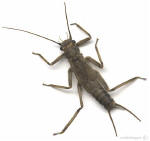 |
|
| |
"Yakima-Shortwing Stone-Male" |
|
|
Stonefly nymph
migrations on the Yakima generally occurring during the
latter portions of the day, late evening and early morning.
If you are in search of larger sized rainbows, the first
portion of your day is a good time to cast large sub-surface
stonefly imitations.
When mating
between the species occurs, afternoon flights from the egg
laying female is a appropriate time to pound large dries to
bank feeding opportunist. |
|
|
|
|
During mass movements
and gatherings of stonefly nymphs, trout feed heartily on this
sub aquatic form. This large, protein packed banquet of
aquatic creatures is easily plundered. If your artificial
is presented correctly, the trout will enthusiastically seize
the opportunity and snatch your imitation. Work
the appropriate holding water in each run diligently. |
|
|
|
|
|
Summer Caddis are also
a viable options for early evening dry fly fishing as dark,
blooms of Caddisflies dance uncontrollably above the water
at dusk. Hatches are also sporadically occurring
throughout the day in some areas of the Yakima. |
|
|
|
|
|
|
|
After temperatures
surpassed the triple digit mark in the Kittitas Valley,
significant water releases have driven the water volume on
Central Washington's fly fishing river to normal summer
operating levels. River flows have increased as stored
water is being discharged from the Yakima's reservoirs.
Spring flows had remained low throughout most of the month of
June, accommodating foot fishermen. Low river volumes
provided everyone the opportunity to move about the entire
river with ease. Now, wade fishermen are bank fishermen.
The Lower Yakima below the confluence of the Cle Elum River has
become primarily a boating river. Those prone to wade
fishing the lower sections can still find some areas where
braids and bank access allow, however these spots are sparse. |
|
|
|
With water flows
rising, many more holding areas within the river have provided
relief for the trout, dispersing concentrations of several
Yakima River fish species that have been podding in the river
runs together since spring. Focus your attention on the
trout's summer holding water to procure the desired effects. |
|
|
|
With warm temperatures
just beginning, aquatic insect hatches are sporadic during the
heat of the day. The Pale Morning Duns emergence begins
mid-morning and fades during the peak of the afternoon.
Yellow Sallie Stoneflies are prevalent during the heat of the
day, especially in some area's of the Upper Yakima.
Terrestrial fishing is just beginning as good numbers of Hoppers
in various colors are beginning to grow along the grassy banks
of the river. |
|
|
|
The stoneflies
continue to be the big story on the Yakima. We are already
seeing substantial numbers of the female summer stones, the
Shortwings. These are large size stonefly nymph, only
slightly smaller than a Salmon Fly. Trout enthusiastically
batter imitations during the heat of the afternoon, especially
in areas where the concentration are densest.
|
|
|
|
Its hard to say this
year when we will begin to see the big female adults. The
smaller male nymphs have yet to show along the banks for mating
purposes. As soon as this occurs, Shortwing Stone activity
will be clamoring along the banks of the Yakima. |
|
|
|
 |
As
we spend the day celebrating with family and friends
the independence that this great country provides us, lets
not forget the service men and women deployed in the Middle
East and other parts of the world.
Though the
people of Iraq may not appreciate your sacrifice and
dedication to freedom, Americans at home do!
Thank you from the staff & management of W.B.F.C.
Have a safe and
peaceful 4th of July. |
|
|
|
|
|
|
|
As the Cottonwood
tree's shed their seasonal, fibrous matter and the monstrous
Monarch Butterflies flutter along the banks of the Yakima on
there journey southward, the summer fishing is underway on
Central Washington's, trout stream.
|
|
|
|
A release of water
from the Cle Elum Reservoir into the main stem of the Yakima has
taken place over the past two days. The river flows are on the
rise, however the river is still in excellent fishing condition
and the water releases are only being discharged in small
increments at this time. Wade fishing is still an option
in some areas, however on foot fishermen are not necessarily
going to find it as easy as it has been.
|
|
|
|
A low volume of ompetition for
superior day time holding water between Yakima Rainbows and
Rocky Mountain Whitefish has been occurring . Now that the
river has an added volume of water, additional holding areas
have been created, leaving the runs less congested with
concentration of Whitefish. |
|
|
|
The warming
temperatures this week have brought on daily Caddis hatches
throughout the river system. Some areas are seeing better
blooms then others, although consistent hatches of Pale Morning
Duns, Pale Evening Duns, Little Yellow Mays and Yellow Sallies
have kept the fish busy during the day if Caddis are non
existent. |
|
|
|
The stonefly fishing
this year throughout the river has been remarkable. The river
has been literally ingested with stoneflies this season and the
migration of Golden Stones marches on. Large, dark bodied
imitation that reflect the natural continue to produce results
throughout your day of fishing. With low flows operating
throughout the summer months, it should be very interesting to
see the quantities of summer stones that converge over the
Yakima's waters. The Shortwing Stonefly, typically
begins migration during the latter portions of the month of
August. |
|
|
|
As the cooler
temperatures resided over the Yakima River Valley during the
latter portion of May and the first days of June,
Blackstone Lake continued to fish into the first week of
June. The lake has now closed for the summer and will open
up once again under the management of Worley Bugger Fly Co
sometime during the first portion of September. On going
labor will be conducted at the lake over the summer months fine
tuning it for Fall fishermen. Lake bookings begin filling
in August for Fall fishing at Blackstone. Don't hesitate
to call in advance to reserve your group's fishing day. |
|
|
|
|
|
With the warm days of
summer quickly approaching, the erratic weather conditions
continue to persist throughout the Yakima River Valley.
Warm, scorching days precede over cast, cloudy days mixed
with strange unseasonable thunder showers. Not that we are
complaining. The valley, hillsides and mountains all needs the moisture as the majority of the
western states once again face the certainty of another summer
drought. |
|
|
|
Earlier this week, we
spoke directly with the Bureau of Reclamation management
team in charge of the Yakima River water operations.
Trying to get a definitive answer from them is like beating your
head against the wall. What they could tell is to expect
lower river flows throughout the warm months of summer. The river will
flow well below the normal operating volumes that we usually
see during the months of June, July and August.
Discharging dates from the reservoirs could not be obtained,
however we were told the water would be released to meet the
irrigation requirements for farmers in the Kittitas and Lower
Yakima Valley as needed. |
|
|
|
As of today, the river
continues to flow well below the monthly average. Wade
fishing for those without boats still isn't a concern.
Floating the river is always a much more productive way to fish
the hatches, however the wading angler will find little
resistance from the river at this time. |
|
|
|
So, we as fly fishermen continue to
enjoy the low water flows throughout the entire main stem of the
Yakima. The cloudy, overcast days are providing plenty of PMD, Caddis and Yellow Sallie activity. The mixture of
Golden Stones is still apparent in some areas of the river.
|
|
|
|
Click To Enlarge
Thumbnail |
|
|
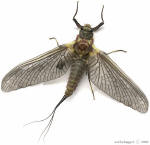 |
|
"Yakima-Green Drake Mayfly" |
|
|
|
The "Green Drake Mayfly"
activity is now apparent in some sections of the river as well.
The Yakima Green Drake hatch is a far different emergence than say the
Green Drake of the Big Hole River in Montana or the renowned
Henry's Fork in Idaho.
As you can see, the
river
does have an ample source of Green Drake Mayflies. Is it a consistent daily hatch like Baetis,
March Browns or PMD's. No. However, if you happen to
be in the right area of the river where the hatch is known to
exist, you may encounter this giant mayfly.
Be prepared if you
happen across this interesting, gigantic mayfly through the
month of June when boating or wading the Yakima. It's generally an
afternoon emergence, lasting just a short while. Come
prepared with imitation to match the natural as big a #6.
|
|
|
|
Small Baetis become a feeding factor on these days as well.
The sweltering hot days that we experienced late last week,
where high temperatures were topping the 90 degree mark, provide little aquatic insect activity during the heat of the
day. Nymph fishing or casting attractor imitation has
rendered successes. Once the early evening arrives and the cooler
air descends over the river, the bug activity begins to stir. |
|
|
|
|
|
After spending several
days fishing east of the Great Divide, amongst the great rivers
of Southwest Montana, I returned to find the spring insect
hatches still flourishing on the Pacific Northwest's, Yakima
River. Continued emergences of Mayflies, Caddisflies and
Stoneflies persist over the waters of this fabled
Central Washington fly fishing river. |
|
|
|
With the water volume
still unseasonablely low for this time of year, resident fish
are taking advantage of the situation. Fueled by a
variation of insect emergences throughout the day, fish are
feeding on a diverse assortment of aquatic creatures. With the
Memorial Day weekend started, fishermen in boats and those
walking the banks are utilizing the effects of the low water
conditions as well. |
|
|
|
Pale Morning Dun
Mayflies
(P.M.D.)
are an afternoon treat for those looking for match the hatch
fishing. Caddisflies are thrown into the equation during
the day with sporadic blooms appearing in a variety of sizes and
colors. With the erratic weather conditions still
prevailing, cloudy overcast days are still providing some Baetis
fishing as well. |
|
|
|
Stoneflies have been a
constant in the diet of the Yakima Rainbow this season as the
Golden Stone continues to emerge. Stone nymphs fished
subsurface have been a consistent producer. However, if
you happen to encounter a hatch of adult stones, the trout are
attuned to the large dry fly imitations. The Yellow Sallie
action has slowed for the time being, perhaps due to the cooler
air temperatures. The month of June will provide us with
plenty of sallie action. |
|
|
|
June is also the time
to lend thought to terrestrial fishing and its importance.
Higher water flows on the Yakima, combined with warm, windy days
provide bank feeding fish with a nourishing, unexpected,
inviting meal. |
|
|
|
As
the Memorial Day weekend arrives, lets not forget the reason we
celebrate the last Monday of May. The staff, management
and professional guide team of Worley Bugger Fly Co. would like
to express our sincere appreciation to the service men and
women, past and present as well as their families for their self
sacrifice and dedicated service to this great nation. We
wish everyone a safe holiday weekend. |
|
|
|
|
|
|
While the spring
fishing continues, weird, erratic weather eclipsed the hillsides
of the Kittitas Valley. Earlier in the week,
sporadic rain showers mixed with dark clouds rolled over the
central section of the state rejuvenating the hill
tops and rivers streamside foliage.
The water volume remains unseasonable low for the month of May,
which in turn is procuring an absolute abundant variety of
aquatic insect activity. |
|
|
|
|
With river flows low,
trout continue to hold in pods. However, with warming water
temperatures the rainbows are moving to summer holding lies,
retreating into the cooler water leaving other resident fish
species to the warmer areas of the run. Concentrate your
efforts in specific water types for the desired effect. |
|
|
|
Since early December,
the Yakima has been producing an absorbent amount of stonefly
activity. Skawala Stoneflies were amassed along the
banks through the winter and early spring months. The
Yakima rainbows spent countless
energy reserves gobbling this early spring forage.
|
|
|
|
During the month of
April, Salmon Fly nymphs and adults were prevalent in sections
of the Yakima River. Consumption of this notorious
stonefly occurred over a several week period. Now,
profuse numbers
of Golden Stone nymphs are in migration along the river bed of
the Yakima. Another proportionately, large stonefly
migrating in low water conditions has literally become a
crawling target for Yakima rainbows. The adult stonefly is also
present during the early
parts of the afternoon as well throughout sections of the river.
Working large dry flies in specific areas of the river in an
appropriate matter will alert attention. |
|
|
|
On warmer days, Yellow
Sallie Stoneflies are also making an appearance in upper
portions of the Yakima. The nymph stage of this
aquatic creature will become an important factor in your fishing
during the month of June. Good numbers are already appearing in
the substructure throughout upper portions of the river at this
time. |
|
|
|
The emergence of
Caddis remain a constant daily event over the waters of the Yakima.
Some sections however are experiencing a more robust bloom on a
regular basis. Several species in a variety of colors and
sizes are occurring throughout the day. Expect the Caddis
activity to remain consistent and continue
hatching over the warm summer months. |
|
|
|
Pale Morning Dun Mayflies
are also adding to the mixture of aquatic activity as well.
This early afternoon mayfly emergence is conducting attention
throughout the main stem of the Yakima. The P.M.D. nymph, a
swimmer has become an intricate part of the trout's diet.
Nymph your favorite imitation during the first parts of the day.
Perhaps in conjunction with a stonefly nymph and reap the rewards.
|
|
|
|
|
|
As we prepare to celebrate the Mothers of America, it's Caddis time and
several different varieties and sizes are appearing over the
waters of the Yakima. Small Grannom Caddis and large
olive-brown Sedge Caddis are making a daily appearance on Central
Washington's infamous fly fishing river. |
|
|
|
Click To Enlarge
Thumbnail |
|
|
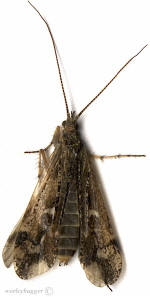 |
|
|
|
This emergence is
generating a familiar interest throughout the main stem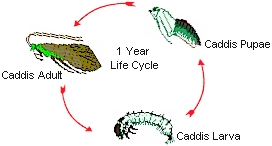 as the rainbows enthusiastically dine on a well rounded diet
of pupa, emergers and egg laying caddis adults.
as the rainbows enthusiastically dine on a well rounded diet
of pupa, emergers and egg laying caddis adults.To fish
effectively, be prepared to encounter the full stage life
cycle of this rather interesting aquatic creature. A
variety of sizes and colors that duplicate the life cycle is
important to posses when fishing the Yakima this time of
year.
The March Brown
Mayflies are
phasing out for the season in the majority of the lower river.
This afternoon emergence is still occurring in some sections of
the lower stem, although their appearance is sparse at best. The
upper reaches of the
Yakima are still producing some good activity at this time.
|
|
|
|
|
While one mayfly
completes its life cycle, another begins forming. A sporadic emergence of P.M.D.'s
(pale morning duns) has been occurring in some sections of the
Yakima as well. With aquatic insect hatches cycling
earlier than expected this year, the month of May is producing this important food fueling mayfly hatch. At
this time P.M.D. nymphs are clinging to the rivers
substructure, so be prepared with artificials that replica these
naturals. |
|
|
|
Salmon Flies in both nymph
and adult stages continue to entice the Yakima Rainbows as well.
Stonefly casing are apparent along the banks of the river where the
metamorphosis from nymph
to adult form had taken place. This is a key
indication to a fly fishermen that are one time these large nymphs
were stirring some very important curiosities. A keen eye and a close
examination of your surrounding can at times tell quite a story. The
upper reaches of the river are seeing a large movement of giant
stones this year. This after the lower stem had produced some
rather hefty numbers of nymphs last season. The sub aquatic representation
is an important food item, much more than the adult. However,
if you find the yourself in the right set of circumstances, fishing the adults
dry fly can be
extraordinary. |
|
|
|
The staff, management and
professional guide team of Worley Bugger Fly Co. would like to wish
all the fly fishing mothers a " Happy Mothers Day." Enjoy your
Sunday, you deserve it!. |
|
|
|
|
|
|
|
As the ashes still smolder
along the hillside of the Eastern Cascades from this years first
forest fire sparked by an out of
control burn, spring fishing on Central
Washington's Yakima River continues. Harsh spring winds
whipped over the valley on Tuesday, fueling the flames along the
Upper Kittitas County hillside. After a week of steady,
low flows, the river has soared in volume.
However, as of today the rivers water clarity and conditions are fine and the Yakima is fishing! |
|
|
|
The river continues to
offer a variety of aquatic insects cuisine. Blizzard
Caddis hatches are occurring daily throughout the lower main
stem as well as March Brown and Baetis Mayflies in the early
afternoon. Salmon Fly nymphs and adults are also drawing
attentions through the main stem of the Yakima. The
gigantic orange bodied adults
have arrived early this year and the Yakima rainbows are taking
advantage of the feeding opportunity. Fishing big surface
and subsurface imitations in areas of interest has produced some
fine fishing over the past several days. |
|
|
|
The night time
temperatures continue to remain at or below the freezing mark,
which will help to keep the river stable and in a fishable state. Warm day time
sunshine is predicted over the next several days with the
weekend forecast looking great for some late April
fishing. |
|
|
|
For those prone to the
still waters of the state, Callibaetis Mayflies as well as Damsel nymphs and
female adult Damsels (tan-olive) are hatching on the quiet waters of
the Central Washington Basin. Chironomids are a consistent
main stay, however this afternoon dry fly distraction is an added bonus
in the days fishing opportunities.
Blackstone Lake is now offering these three unique aquatic
insect hatches during the day. Fishing at the lake
this spring has been exceptional and with weather conditions
constantly improving, May undoubtedly will produce the finest
months fishing. Call the pro shop for booking and tour
availablity. |
|
|
|
|
|
As the cold nights
continue their persistence, the beautiful, warm spring days take
precedence over the Yakima River Valley. With river
flows at prime condition for this time of year, a wide
variety of aquatic insects are making their presence known over
the waters of the Yakima. |
|
|
|
Blizzard Caddis
hatches are occurring in areas of the river and the resident
rainbows are far from selective in their undertaking when
feeding on
this aquatic insect. Emergers, pupa and adult patterns in a
variety of sizes from 12 to 16 are working well where encounters
with this spring emergence occurs. Those floating the river
have a strategic advantage moving from one area to another,
concentrating on the key areas where big blooms are happening.
The appearance of feeding River Swallows swooping and diving
along the water surface is a key indication that insect activity
is apparent. These are areas to focus your fly fishing
efforts. |
|
|
|
Baetis and March
Brown Mayflies, continue to entice fish in the early parts of the
afternoon. Baetis are a mainstay in the diet of the trout
with both nymph and adult being equally important. However
for a short time, the larger of the two mayflies becomes the
predominate source of interest. Each day and section of
river is different in the emergence exposure of these mayflies. |
|
|
|
The Skawla activity
throughout the main stem of the river has slowed, however a few
stragglers continue to show a presence. The larger Salmon
Fly nymph is now a much bigger interest and attraction. Some
section of the main stem are prematurely experiencing some adult
activity at this time. With flow conditions low for this
time of year, water temperatures are increasing during the warm
days. This is driving a variety of activity for aquatic
insects nesting in the waters of the Yakima. With water
temperatures rising, holding lies as well as aquatic activities
are motivating Yakima rainbows to seek a variety of different
water forms as well. |
|
|
|
With warm sunny days
filling the skies of the Kittitas Valley, predictions for
weekend fishing couldn't be better. If you are waiting for
spring fishing to arrive, don't wait any longer. Put off
the honey do's and head to the Yakima or your favorite still
water. With warming day time temperatures, the fly fishing
still waters of Central Washington are propelling insect activity as well.
Callibaetis Mayflies action is already occurring. Fish
have been feeding readily on the adult duns in the latter parts of the
afternoon. Damsel nymphs are also entertaining some action
in local area and basin still waters. |
|
|
|
April 15th-2004 |
|
|
As the Yakima Rivers
spring surge of water steadily makes a descent, the April
aquatic insect emergence is intensifying on tax day 2004. A wide range of
insects and organisms are filtering throughout the rivers system and the
Yakima's rainbows are taking advantage of the situation.
Be prepared to encounter several different species during your
day of fishing. |
|
|
|
|
Midge and Midge
Clusters have literally sheeted the surface of the water in many
of the sections of the Yakima. Orgies of clusters are
forming in the eddies and foam lines creating an enticing meal
for a foraging rainbow. The Skawla Stoneflies are still a
component during your day of fishing, however some areas of the
river are starting to see a decrease in
activity. |
|
|
|
As we see the
departure of one stoneflies for the season, another
quickly steps into to fill its place. Salmon Fly nymphs,
the undisputed king of the stones is once again on the move,
crawling along the river floor as their mighty migration has
begun. |
|
|
|
At this time, some
sections of the Yakima are experiencing a large
migration
of this giant stonefly. When presented with the right set
of circumstances, a rainbow will hardly pass on the opportunity
to fill its belly with this large protein packed meal. Dredging
a large imitation on a drag free line will most likely reward
successes. |
|
|
|
The Baetis emergence
is steadily occurring during the first portions of the
afternoon. Fish quickly hone their feeding intuitions to
the blue wing duns. However, when the March Brown Mayflies
litter across the water, attentions quickly turn to the larger of the two mayflies.
Be set up and ready in an area of the river with a pronounced emergence for this short
lived hatch of aquatic insects. It lasts only a
short while, but is now producing some very exciting
fishing. Once it begins to
fizzle and fade for the day, concerns for many of the trout will most likely return to another
aquatic form. A
keen eye for detial will be needed to determine just which fair
it is . Caddis Emergers, Midge Clusters or Baetis? |
|
|
|
A small spring squall
blew across the upper county earlier in the week creating a
surge of water gushing through the main stem of the system.
Today, the river continues to drop, thanks to the cold nights
and cool spring days. Conditions couldn't be better for weekend
fishing. As we approach the irrigation season, farmers
around the valley have been busy clearing weeds and other debris
from water canals and fields. Some of the over cast, hazy days
are contributed to controlled burning throughout the Kittitas
Valley. |
|
|
|
April 6th-2004 |
|
|
After a succession of
chilly spring nights, the fly fishing days on Central
Washington's Yakima River beam with warm, sun filled afternoons.
The cold nights are expected to continue, which we favor this time
of year. The sizeable snow pack that remains in the
Cascades is steadily liquefying during the day. A far better
scenario then what could occur. |
|
|
|
|
The river flow has
spiked over the past couple of days and although high, the
Yakima as of today remains
in excellent fishing condition. With sudden fluctuations
in stream flows which has been occurring frequently, aquatic organisms and other earthly matter is
constantly being sweep into the rapidly changing currents.
A drag free presentation of your imitations is crucial for any successes.
Wading anglers looking for good spring holding water to fish
will have to carefully pick your spots. |
|
|
|
 Click To Enlarge
Thumbnail Click To Enlarge
Thumbnail |
|
|
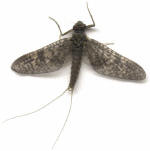 |
|
"Yakima-March Brown Mayfly" |
|
|
Even though water
temperature remain low with constant fluctuations, the warm
sunny days are producing a smorgasbord of aquatic insect
activity. Skawala Stones, Baetis, March Brown
Mayflies, Midges and Caddis are all present throughout the
Yakima's main stem.
The flurry of
activity is beginning by mid-day as the air temperature
quickly ascends to a comfortable degree. Skawla
Stones, both the adult and sub aquatic form are
consequential during the first portion of your day due to
night time and early morning migrating periods.
By early afternoon
the trout's taste change. Baetis Mayflies as well as Caddis
Emergers become the primary target for foraging rainbows.
|
|
|
|
|
|
|
Within this mixture of
insects, March Brown Mayflies suddenly appear, gathering in the foam
lines of the river. Some areas of the river are producing a more concentrated hatch
of these large mayflies at this time. As the days
progresses the emergence of March Browns will only intensify.
Those anxiously waiting for consistent dry fly fishing to begin,
wait no longer. |
|
|
|
March 30th-2004 |
|
|
While the water volume continues to
recede, spring time aquatic insect activity has
been heating up on the Yakima. As the cfs
(cubic feet per
second) flow steadily drops,
the warm Kittitas Valley days are fashioning the required water
temperature for an April emergence of mayflies. |
|
|
|
|
The past week, midge balls or
cluster have congregated through areas of the river forming an
orgy of drifting insects. A welcome site along the foam
lines and seams for a opportunist like the Yakima rainbow. |
|
|
|
The egg laying Skawla Stonefly has
also been actively doing her part to insure a future generation
of spring stoneflies. The sub aquatic representation of this
aquatic form continues to be a main source of nutrients as well. |
|
|
|
Baetis nymphs in most areas of the river
have also become an
intricate part of the rainbows diet. Fished appropriately
within the water column and the gathering foam lines of the
river should produce the desired effect. By early
afternoon, the adult duns will become fair for the Yakima
rainbows as rising trout feast on these spring mayflies. |
|
|
|
With water temperatures still below
the 45˚ mark, fish of all species are holding
in specific, spring water types. While fishing the river,
concentrate your efforts on these essential
areas of the Yakima. |
|
|
|
The March Brown Mayfly activity
that we so anxiously await is beginning, but in slow stages.
Sporadic emergences of these April mayflies is appearing lightly
in the lower Yakima River Canyon. However, areas of the
river that produce far greater numbers of the
Rhithrogena Morrissoni
have yet to
materialize there. |
|
|
|
As water flows continue to recede,
the river temperature will inevitably warm, producing the
springs best match the hatch fishing. This typically occurs
as the water
approaches the 46-47˚(degree)
mark. |
|
|
|
The still water fisheries of Central
Washington have also been reporting days of good spring fishing.
The warm, sunny days are providing the adequate retreat for many
anglers as they travel to the eastern basin. The private still waters such as
Blackstone Lake
is also providing good, quiet
fishing days. The larger rainbows are reacting to the warming
waters and have begun cruising the banks in search earthly
aquatic substance. Booking days for April are popular with a few
still remaining. If interested, please contact the Worley
Bugger pro shop in Ellensburg for availability. |
|
|
|
March 18th-2004 |
|
|
As the Yakima's water
conditions continue to operate at powerful spring flows, an
erratic change is occurring daily within the system. This
disturbance is generating some rather distinct scenarios within
the feeding column. |
|
|
|
|
A variety of matter,
such as leaves, moss, small twigs and other vegetation that is
usually settled is being continuously agitated throughout the
water column. Along with this earthly matter, a diverse
assortment of aquatic organisms are also being sweep through the
system. |
|
|
|
With the higher flows
and cooler water temperatures, the trout have retreated to
specific water types. Bank feeders are holding tight and
will eagerly snatch a streamer if given the opportunity.
Be prepared to fish a variety of
techniques if you plan on spending time on the river this spring.
With fluctuations in water flows, feeding circumstances and
opportunities are constantly evolving. |
|
|
|
The spring wind that
is notoriously associated with the Kittitas Valley has also been
routinely present during the day. By afternoon, the
Cottonwood are bending and swaying as a howling rumbles through the
tops of the trees. However don't let
this discourage you. Their are several areas
of the Yakima where adequate cover exists. If you find
these places, a fly fishermen can enjoy the warm, beaming sunshine
and easily cast a line to the resident rainbows. |
|
|
|
The breeze is
working in conjunction with the higher water fluctuations.
Unable to break the surface tension in windy areas, sub-aquatic
mayflies are simply prevented from
emerging. Here they lie stranded under the surface
film still incased in their meniscus. The trout have a bounty of
sustenance at their
disposal and are eagerly taking advantage of the feeding
opportunities.
|
|
|
|
Skawla Stonefly adults
are showing throughout the river, however not in large numbers
throughout its entirety. We are covering all areas of the
river from Cle Elum to the Lower Yakima River Canyon and have
yet to see a major presence of this flight-less stonefly.
The Lower sections of the river, through the Yakima Canyon by far have showed the most
activity. With conditions varying daily, the adult
presence could occur any time. |
|
|
|
March 12th-2004 |
|
|
A secession of warm, sunny days
has produced a new record for March weather temperatures in the Yakima River
Valley. This in turn has reeked havoc on
the lower rivers water conditions. Water flows increased earlier
in the week and by Tuesday most of the lower Yakima's water
clarity had been compromised. The culprit. Warm weather,
a large snow pack and a host of tributaries feeding the lower
Yakima River. |
|
|
|
|
As of today, water flows have
peaked for the time being. Water clarity in the lower river
below the Teanaway remains at less than a foot of
visibility. With night time temperatures still
dropping below the freezing mark, conditions could dramatically
improve in the next 24-36 hours. However, rain showers are
forecasted for Friday throughout the valley, which in turn could
make matters even worse. This time of year under these
conditions its really a day to day observance of the river,
weather and water conditions. Those that fish the
river on a regular basis will remember dealing with this
same type of river situation this time last year. Call the
pro shop for an up to date report. |
|
|
|
The upper Yakima above
the confluence of the Teanaway remains in fishable condition,
despite the deterioration of the lower sections. Insect
occurrences have been sparse during the week with sporadic
emergences of Baetis hatching during the afternoon. No
sign of adult Skawlas in the upper portions that we have
witnessed as of yet. Hordes of sub aquatics are nesting in the
rocks in this area and could show signs of adulthood any day.
However, water temperature
throughout that portion of the system remains below the 45˚ mark. |
|
|
|
For those hoping to
see March Browns in the coming weeks I wouldn't' get your hopes
to high. The emergence of these large, exciting mayflies
doesn't begin stirring until the first part of April. By
that time were all hoping for a cooperating river. |
|
|
|
For the fanatical
still-water fly fishermen, the basin lakes are reporting a
resurgence in activity after getting off to a slow opening at
the beginning of the month. With warming weather over the
past week, the Midge fishing has intensified on Lenice, Nunally
and Lake Lenore. Go prepared with a variety of colors and
sizes. Feeding activity and preferences are changing
daily. Reports from our guided still water trips on
Blackstone Lake are
ranging within the same boundaries. Warming temps are
producing more Midge activity, especially in the mornings and
early evenings. Reservations for spring fishing are
thinning. Those looking for the latter parts of April thru
May should reserve your spot now! |
|
|
|
March 3rd-2004 |
|
|
As the month of March
begins, a variety of aquatic forms are now stirring
throughout the water column, diversifying the feeding
opportunities for the Yakima River Rainbows. Elements
evolve daily as the rivers water temperature begins to rise. |
|
|
|
|
Most days, warm sunshine beams brilliant rays
over the river basin. Other days, like today, a winter
snow storm invades the Kittitas Valley, leaving a thin blanket
of cover.
Annual aquatic episodes that occur during the regeneration of
spring are apparent throughout the main stem of the river.
Mayfly nymphs that cling, burrow or swim along the river bed are
wandering, providing an assorted ingestion for the resident
rainbows.
|
|
|
|
Stonefly nymphs have
been a ample source of dietary consumption throughout the winter
months and continue to supply essential sustenance as well.
Nests of Skawla Stone Fly nymphs have massed along the shore waiting for
the opportune time to emerge. Adult activity is sporadic
at best., however with the warming days this clash of unrest could break lose any day. |
|
|
|
The river conditions
remain constant with very little fluctuation despite some of the
smaller tributaries discharging a mixture of snow and ice into the main stem. The majority of activity begins mid
day with consistent action on subsurface imitations.
|
|
|
|
Surface presentation
begins in the afternoon as Spring Baetis begin to form over the
waters of the Yakima. Dry fly fishing is under way as the
Yakima rainbows partake in sipping these small mayflies from the
surface Pods of fish enthusiastically display a show of
rising rings, relinquishing their holding lies. |
|
|
|
Many of the public still
water fisheries around the state are now open. The management of
Worley Bugger Fly Co is pleased to announce the spring opening
of
Blackstone Lake, a private still water located in the Yakima
River Valley. Chironomid and scud fishing will be the criteria during
the month of March. Spawning rituals are already underway in
the south end of the lake. Since ice off, we have been
monitoring the proceedings and they were already building redds under the sheet ice.
|
|
|
|
The lake and fish are in
excellent condition once again this year. Blackstone Lake had
its most popular fishing year in 2003. With days being reserved well in
advance, opportunities to fish this private still water are filling
quickly. Please make your group reservation early this year. |
|
|
|
|
|
It's early Monday
morning and the sun is beginning to rise over the central basin,
warming the Yakima River Valley. The deep snow pack that
piled along the banks and hillsides throughout the
month of January is beginning to soften, disappear quickly under
the Central Washington sunshine. A welcome site as the
month of March approaches. |
|
|
|
The day commences with
a cool, crisp morning. However, by mid afternoon the Central
Washington sunshine is booming across the basin, creating
pleasant 40+ degree fishing days. With warming day time
highs and increasing water temperatures, the Yakima's sub
aquatic life is starting to stir.
|
|
|
|
This past weekend,
Blue Wing Olive Mayflies began appearing in areas of the Yakima.
The trout's attentions are now turning to a variety of food
forms as Baetis nymphs free float throughout the water column.
The Skawla Stonefly nymphs have been a major source of nutrients
for the Yakima Rainbows over the past several months. This
continues to be the case and they will remain an intricate part
of their diet over the next several weeks. Adult activity
is sporadic at best as of yet. Some area's of the river
produced small numbers of this spring stonefly over the weekend.
|
|
|
|
By the beginning of
March, the adult stonefly will play an active role in the
trout's consumption and the Yakima River fly fishermen's day.
This activity will occur throughout the major portions of the
main stem. |
|
|
|
The ice is breaking up quickly on
Blackstone Lake as a majority of this premier still water
fishery is now opened. The south end of the lake, shaded by
Poplars and Willow trees remains covered with a thin layer of sheet
ice. If day time temperatures persist, this section of
the lake will become available for fishing. |
|
|
|
The rainbows have wintered well, despite
the harsher conditions they experienced this winter. We have been
sampling the lake a few days a week for short periods of time,
testing fly patterns and examining the fisheries state. The fish
are foraging heartily on scuds, leeches and chironomids as remnant plant
growth from last summer is breaking away. Many of the 2 pound
fish from last year have gain excessive girth. It is possible the lake will
open this week. Bookings for spring fishing are filling. The lake has
grown very popular over the past couple of years under the
management of the Worley Bugger guide team. Please call ahead
this year to reserve your groups place.
|
|
|
|
The Worley Bugger-Yakima River guide schedule for
March is filling quickly with some spaces still available. Our
winter rates will remain in effect through the end of February.
Please refer to our
new price list for the upcoming season. |
|
|
|
February
11th-2004 |
|
|
As the days of
February count away, day breaks on the Central Washington's
rainbow trout stream, producing a foggy, thirty degree morning.
However, by early afternoon the famous Kittitas Valley sunshine
is booming across the basin warming everything. And what's
better yet, more of that warm light continues to last as the hours of the day grow longer. This means
winter is on its way out and spring in the beautiful Yakima
River Valley is approaching. With the change of seasons,
aquatic forms that have lied secreted, growing over the past
years time will once again flourish on the waters of the Yakima
River. |
|
|
|
The fishing has
remained consistent over the past week as a variety of fish
species combat for territory and holding lies within the runs of
the river. Flows have dropped considerably, leaving less
water for optimal feeding efficiency and congregating fish
throughout the prime lies of the river. |
|
|
|
The dynamics of the
Yakima are constantly changing. When these seasonal
changes occur, aquatic creatures that live within the confines
of this change are forced to adapt or another species becomes
dominant. As a fly fishermen you are forced into this
change as well, whether you know if or not. If you adapt
you can be successful in your fishing. Don't be naive in
thinking because it's late winter fish aren't eating. |
|
|
|
Ice is thawing and
loosening across the river and lakes of the valley as midge and
midge larva are susceptible to foraging fish. In addition to
that food form, Skwala Stones have been migrating to mating
grounds along the
banks of the Yakima since December? |
|
|
|
The water temperature
still remains in the upper thirties, to cold to produce adult
activity. However, remember this is a early spring stonefly.
Adult activity will begin when the water temperature warms to the
mid forties. |
|
|
|
The upcoming "Fly Fishing
Show" in Bellevue is approaching. We have had numerous calls
and emails inquiring about our attendance this year. I have to
say, unfortunately we will not be attending. Although we
felt it was a good show last year with some very good spot light
guest speakers, we have found it
nearly impossible this year to justify shutting down our business,
especially our
guiding business for three days to attend. Our
schedule has kept several of us busy this winter and we are not
seeing a reprieve in the bookings for February fishing. So
while others attend we will be busy working. |
|
|
|
Our spring dates for
fishing the Yakima and our private still water fisheries are filling
quickly. We are encouraging an early booking this year for
spring fishing on both the
Yakima and
Central Washington's premier still water,
Blackstone Lake. To
arrange your favorable day on both fisheries, please call in
advance. Winter rates will remain in effect through the end of
February. |
|
|
|
February
1st-2004 |
|
|
|
|
It's Super Bowl Sunday, the first day of February and once again
a light dusting of snow has fallen overnight around the Kittitas Valley.
A warming trend earlier in the week fashioned a thaw, initiating
the snow pack melting process. This effect in turn created
many of the small creeks around the valley to swell. These
small, bloated tributaries released a surplus of water into the
main stem of the river causing a rapid increase in water
conditions. |
|
|
|
|
|
Consecutive cooler
days and nights now has the river receding. Much of the
valley snow that
had fallen earlier in the month has quickly began to disperse,
however the basin hillsides still show an apparition of a much
harder winter than the previous years. |
|
|
|
|
|
Today's weather glows
as sunshine and blue skies abound across the basin.
However, forecaster are calling for a likelihood of incoming
snow showers over the valley the next couple of days.
Basin winds are also projected along with the storm, which
should help expedite the snow melt if it should occur.
Watch the gauging stations daily for changes in the river
conditions or call the Ellensburg pro shop for more detailed
information. |
|
|
|
|
|
A
break in the winter conditions is a welcome sight this time of
year. Winter storms and snow decorating the valley streets
and hills around the holidays is pleasing to the eye, creating a
festive feeling. However, by February I am happy to start
to see it diminish and quickly fade away. |
|
|
|
|
|
This cold winter
also showed no reprieve on the still waters of the central region.
Thick ice formed on the valleys premier, private fly fishing waters
as
Blackstone Lake for the first time in many winters completely
iced over. However, the warming weather mixed with the
renowned westerly winds have been rapidly dissolving that thick
layer. Approximately 50 yards of the west end of the lake is
now opened and each day more of the lake becomes available.
The rainbows have steadily begun to feast on Chironomids on a daily
basis. Guided tour reservations have been booking since
December for spring fishing at Blackstone Lake. If you are
interested in fishing this privately managed still water fishery
this spring with Worley Bugger, do not delay in calling.
Once the majority of the ice is thawed, fishing at Blackstone will
open. From what we have seen the past couple of days, we
anticipate excellent fishing in February. |
|
|
|
|
|
|
|
|
As the first month of the year is
quickly departing, relief from the severe winter storm that blasted
the Kittitas Valley is gradually
arriving. The monstrous snow
accumulations that heaped along the banks of the river are slowly
loosening and beginning to soften and melt. Its quite a sight
to see, as drifts over 9 feet tower over many of the trees and
willows along the Yakima River Banks. |
|
|
|
|
|
The fish continue to pick up stones, nymphing
them along the bottom. An additional dropper nymph can be
attached if desired, but its not necessary. Other wet fly
techniques, such as streamers, soft hackles, or buggers can
prove productive some days, but the before mentioned methods are
producing far better results at this time. The river is in
prime condition as weather forecasters are calling for warming
days throughout the better part of the week.
|
|
|
|
|
|
Earlier this week a new Yakima River fly fishermen
was inducted into the brethren. Chuck Cooper, operator of
Cooper's Guide Service, welcomed his son into the world. Clark
C. Cooper was born in Seattle, is a healthy 8lbs-12 oz. and measures
22" inches long. Chuck and his family are of course elated
with their new bundle of joy. Both mother and father are doing
fine. When you see Chuck on the water be sure to congratulate
him! |
|
|
|
|
|
During the below zero
chill that settled in the valley the first part of the new year, the Worley
Bugger Pro-Shop in Ellensburg felt the effects of the cold snap. A
water line burst during the night, spilling water throughout the
entire fly shop. We awoke the next morning to find several
inches of standing water. The mess, as you can well imagine kept us
busy for several days. Since then we have been cleaning up and
trying to get the store back in shape. Since
we had a mess, we decided to make an even bigger one! A fly shop
expansion is underway, creating over a third more space in the store. The
construction should be completed this week and we will have the
store pieced back together. This expansion will again, create the
largest, most complete, professional fly fishing shop in Central Washington,
especially with the addition of several new fly fishing lines
arriving this spring. The store and guide service remains open
during the construction, so please....excuse our mess. |
|
|
|
|
|
|
|
|
After frigid, artic temperatures
stormed through the Central Washington basin, wreaking havoc and
accumulating several feet of snow throughout the valley, warmer
temperatures are now occurring. The slush ice that was
prevalent before the holidays, has cleared leaving crystal, clear
waters. Some sections of the river in the Yakima Canyon are
completely under ice. The portion of river running from
"The Slab" to the Roza Dam is a motionless piece of snow and ice
from bank to bank.
|
|
|
|
|
|
Area's of the river that have a steep
gradient, creating a some moving current remain open and fishable.
Subsurface fishing continues to a be staple and most effective form of fishing.
However, dry enthusiasts are finding some trout "Midging", concentrating their feeding
opportunities on these tiny aquatic creatures.
|
|
|
|
|
|
The Kittitas Valley hasn't experienced
winter storms this severe since "1996-97" At
that time, great floods ravaged the river basin and changed it forever.
The past several years have spoiled us with mild days brimming with
sunshine, leaving the river wide open for winter fishing.
|
|
|
|
|
|
After a brief hiatus from the river,
fishermen have now returning to the Yakima for January fishing.
With portions of the Yakima under ice, selecting a run to fish for
the day is hardly complicated. |
|
|
|
|
|
|
|
|
|
|
|
|
|
|
|
|
|
 |
|
|
306 South Main #3
Ellensburg, WA 98926
888-950-FISH
www.worleybuggerflyco.com
worleybugger@elltel.net
|
|
|
|
|
|
This fly fishing journal
is constructed and maintained by Worley-Bugger for fly fishers by
fly fishers! © 2004 All Rights Reserved |
|
|
|
|
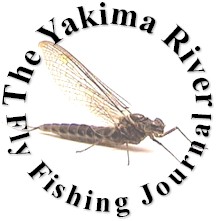
![]()
![]()
![]()
![]()
![]()
![]()
![]()
![]()
![]()
![]()
![]()
![]()
![]()
![]()
![]()
![]()
![]()
![]()
![]()
![]()
![]()
![]()
![]()
![]()
![]()
![]()
![]()
![]()
![]()
![]()
![]()
![]()









 as the rainbows enthusiastically dine on a well rounded diet
of pupa, emergers and egg laying caddis adults.
as the rainbows enthusiastically dine on a well rounded diet
of pupa, emergers and egg laying caddis adults.
